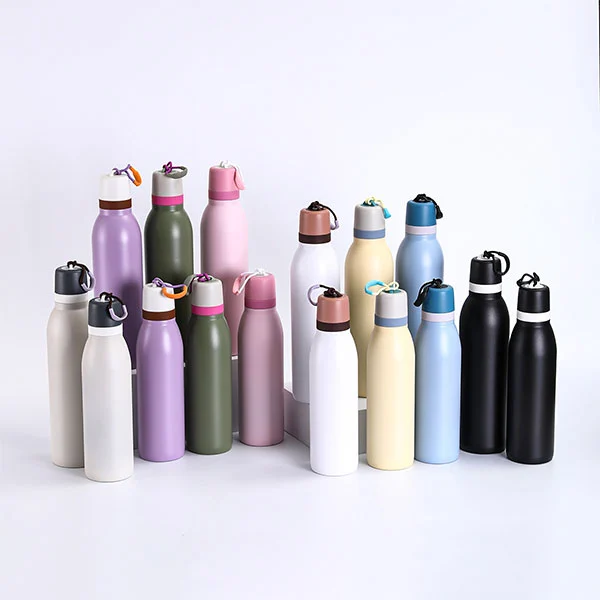- English
- lugha ya Kiswahili
- Bosanski
- Hawaiian
- Sundanese
- Español
- Português
- русский
- Français
- 日本語
- Deutsch
- tiếng Việt
- Italiano
- Nederlands
- ภาษาไทย
- Polski
- 한국어
- Svenska
- magyar
- Malay
- বাংলা ভাষার
- Dansk
- Suomi
- हिन्दी
- Pilipino
- Türkçe
- Gaeilge
- العربية
- Indonesia
- Norsk
- český
- ελληνικά
- український
- Javanese
- فارسی
- தமிழ்
- తెలుగు
- नेपाली
- Burmese
- български
- ລາວ
- Latine
- Қазақша
- Euskal
- Slovenský jazyk
- Македонски
- Lietuvos
- Eesti Keel
- Română
- Slovenski
- Srpski језик
How do Stainless Steel Bottles Become Mainstream by Meeting Modern People’s "Health + Practicality" Drinking Needs?
2025-09-17
As consumers’ demands for drinking water safety and quality rise, stainless steel bottles—with multiple advantages—are gradually replacing plastic and glass bottles to become the mainstream market choice. In 2024, the domestic stainless steel bottle market scale exceeded 9.5 billion yuan, with a year-on-year growth of 32%, among which food-grade 304/316 material products accounted for over 85%. Their outstanding performance in safety, durability, functionality, and environmental friendliness accurately meets the "health + practicality" drinking needs of modern people.

1. Safety & Health: No Harmful Substances, Suitable for Multiple Drinking Scenarios
The core advantage of stainless steel bottles lies in "material safety":
Most use food-grade 304 stainless steel (complying with the GB 4806.9 standard), with heavy metal (lead, cadmium) migration ≤0.01mg/kg—far lower than that of plastic bottles (≤0.05mg/kg);
High-end models adopt 316 stainless steel, which has stronger acid resistance. When holding acidic drinks like coffee and juice, there is no metal ion leaching (tests show leaching amount <0.001mg/L), solving the pain point of plastic bottles "releasing harmful substances at high temperatures."
Tests by a testing institution show that stainless steel bottles have no peculiar smell or migrating substances when soaked in 100℃ boiling water for a long time. Parents give them a score of 9.1/10 for "suitability for children’s drinking."
2. Durability & Sturdiness: Shock-Resistant, Corrosion-Resistant, Long Service Life
The "high toughness" of stainless steel bottles adapts to high-frequency use scenarios:
The bottle body is made of 0.4-0.6mm thickened stainless steel. When dropped from a height of 1.5 meters onto a concrete floor, 98% of products remain undistorted and leak-proof (while the breakage rate of glass bottles after dropping reaches 90%);
The surface undergoes electrolytic polishing or sandblasting treatment, increasing scratch resistance by 60%, with no obvious scratches after 1 year of daily use;
It has excellent corrosion resistance. When storing condiments like soy sauce and vinegar for a long time (24 hours), there is no rust on the inner wall of the bottle. Its service life can reach 5-8 years (vs. only 1-2 years for ordinary plastic bottles). Data from an e-commerce platform shows that the positive review rate for "durability" of stainless steel bottles reaches 93%.
3. Heat & Cold Retention: Strong Temperature Control, Suitable for All-Time Needs
Stainless steel heat-preserving/cold-preserving bottles with a vacuum layer have far better temperature control capabilities than other materials:
Adopting a double-layer vacuum design (vacuum degree ≤5×10⁻³Pa), the heat preservation temperature is ≥60℃ after 6 hours (vs. only ≥40℃ for plastic heat-preserving bottles), and the cold preservation temperature is ≤10℃ after 12 hours—meeting the needs for hot drinks in winter and cold drinks in summer;
Some high-end models add a copper plating layer, extending heat preservation time by 20%. Tests by a brand show that its stainless steel heat-preserving bottle still maintains a temperature of 45℃ after 24 hours of heat preservation, suitable for commuting, outdoor and other scenarios. The "temperature control satisfaction" is 58% higher than that of plastic bottles.
4. Environmental Sustainability: Recyclable, Reducing Pollution
The "recyclability" of stainless steel bottles aligns with the low-carbon trend:
The material is 100% recyclable with no secondary pollution during recycling, making it more environmentally friendly than plastic bottles (with a recycling rate of only 30%);
Calculated based on one use per person per day, one stainless steel bottle can replace about 500 disposable plastic bottles, reducing plastic waste by about 2kg per year.
In 2024, "eco-friendly materials" became a popular search term for stainless steel bottles, and sales of products with "recyclable labels" increased by 47% year-on-year, conforming to consumers’ "green consumption" concept.
| Comparison Dimension | Stainless Steel Cups (304/316) | Ordinary Plastic Cups | Ordinary Glass Cups |
|---|---|---|---|
| Harmful Substance Migration | ≤0.01mg/kg | ≤0.05mg/kg (prone to exceeding standards at high temperatures) | 0mg/kg (easy to break) |
| Service Life | 5-8 years | 1-2 years | 2-3 years (easy to break when dropped) |
| 6-Hour Heat Preservation Temperature | ≥60℃ (vacuum models) | ≥40℃ (some with heat preservation) | No heat preservation function |
| Recycling Rate | 100% | About 30% | About 80% (high recycling cost) |
| Shock Resistance (1.5m Drop) | 98% remain leak-proof | 70% remain leak-proof (easy to deform) | 10% remain undamaged |
Currently, stainless steel bottles are evolving toward "intelligence + personalization":
Smart models with temperature displays can monitor water temperature in real time;
Products with antibacterial coatings (antibacterial rate ≥99%) are suitable for maternal and child groups.
In 2024, sales of such innovative products accounted for 35%. As a drinking tool that balances health, practicality, and environmental friendliness, the advantages of stainless steel bottles will continue to drive their penetration in home, office, outdoor and other scenarios, making them a "long-standing popular product" in the consumer market.




